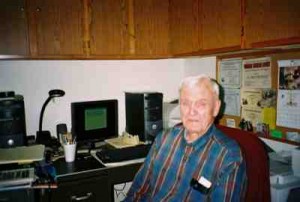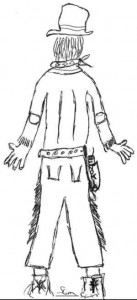Article by Doris Dembosky
Art – September 2005 – Colorado Central Magazine
WHAT’S A PERSON to believe? Are installation artists Christo and his wife Jeanne-Claude monsters or high priests? And what exactly is “Over the River” anyway?
Fresh from “The Gates,” their successful New York City installation that saw 7,500 orange nylon panels hanging above 23 miles of walkways in Central Park in March, Christo and Jeanne-Claude were in Salida on August 1 to jump-start their stalled “Over the River” project.
The weather was golden, the water white, the sky blue. Lean, tanned, bra-less women with good hair and drinks in hand hobnobbed with men in khaki and high-end cameras.
Sitting on the Steam Plant stage, Christo and Jeanne-Claude didn’t look like monsters. He looked like Woody Allen; she looked like Annie Hall. They made a cute couple. Born the same hour of the same day in 1935 (he in Bulgaria, she in France), they charmed the audience with their accents, intelligence, and quick wit.
The positive energy zinging back and forth between the artists and the audience was electric. If detected by surveillance satellites in space that night, the Steam Plant was very possibly identified as the site of a nuclear reactor.
Christo and Jeanne-Claude’s visit to Salida felt like a love-fest, but their visit was not without purpose.
First, Christo and Jeanne-Claude were raising funds for the Steam Plant Theater, and in that, they were successful. According to theater manager Elizabeth Ritchie, ticket sales and the silent auction of 27-signed photographs of their works raised over $3,000.
Their second objective was to let the community know that after a four-year pause for the completion of other projects, “Over the River” is on fast-forward. If the permitting process goes smoothly, the installation could be completed as early as the summer of 2008.
[Christo’s plan for Over the River.]
IMAGINE LOOSELY WOVEN, translucent panels (think of them as shimmering fabric waves) hummocking from cable to cable, ten to 23 feet above the Arkansas River. Although the entire installation will run 40 miles, huge gaps will intersect the seven sections to be installed at the tunnel, Valley Bridge, Texas Creek, Maytag, Three Rocks, Spike Buck, and Parkdale.
Jeanne-Claude described the effect as a “ribbon of Light.” At each point of installation, the individual panel will measure the width of the river. The aluminum-coated fabric will glow pink in the morning, silver at noon, and gold in the evening.
Whatever their vantage point, viewers will be able to see through the fabric to the landscape, skyscape, or waterscape beyond. As a work of art, it is about the interplay of a fluid installation that is sculptural, architectural and painterly in a natural setting of uncommon beauty.
Not everyone is enthusiastic.
IF YOU ADD THE DISDAIN and indifference of the general population to the militancy of appalled environmentalists and the legitimate concerns of public officials, you have a sizable resistance.
Some think that “Over the River” is just plain stupid: “You wanna see laundry? Come to my house. I’ve got sheets dryin’ on the line!”
Others would paint Christo and Jeanne-Claude as environmental terrorists. They envision crumbled canyon walls and desiccated sheep.
Skeptics moan, “Why us?” In short, our river won. After visiting 89 rivers in 1983-84, Christo and Jeanne-Claude narrowed the possible sites to six rivers: two rivers in Idaho, the Wind River in Wyoming, the Rio Grande in New Mexico, and the Cache la Poudre and the Arkansas in Colorado.
Because of its combination of tranquil and turbulent water; its high, red cliffs; and its proximity to a major east-west highway, the Arkansas River took first place.
People who know little of Christo’s work are predisposed to hate it. Like elephants, local folk have long memories. They may not have seen Christo’s “Valley Curtain” installation in 1972, but they do remember that high winds tearing through Rifle Gap shredded the 250,000-square-foot drape. The curtain hung for only 28 hours. Unfortunately, that failure colors the public’s perception of Christo to this day.
But 33 years have passed, and Christo and Jeanne-Claude have learned from their mistakes. Specific to “Over the River,” structural engineers have conducted laboratory, wind tunnel tests in Guelph, Canada, and life-sized tests in a canyon near Grand Junction.
Major legitimate concerns include traffic control and emergency response; the impact on big horn sheep and birds of prey; and the installation of cables into the canyon walls.
If anyone knows about accommodating concerns and revising revisions, it is Christo and Jeanne-Claude. Even two-week, temporary installations call for public review and multiple permits. The permitting process may take years.
But the artists are hardened veterans. It took Christo and Jeanne-Claude 24 years of wrangling to wrap Germany’s Parliament; 26 years to install “The Gates” in Central Park; and 32 years to wrap 178 trees in Switzerland. Say what you will about their art, but you must admit that they are tenacious.
The artists must accommodate the concerns of many diverse groups: the Frémont and Chaffee County commissioners, the sheriff’s departments of both counties, the city governments of Salida and Cañon City, the Police departments of both cities, the Colorado Department of Transportation, the U.S. Forest Service, the Bureau of Land Management, the Colorado State Patrol, the State Land Board, the Colorado State Parks Department, Frémont County Road and Bridge, the Division of Wildlife, the Upper Headwaters of the Arkansas, the Environmental Protection Agency, and the general public.
INSTEAD OF EACH ORGANIZATION requiring a separate permit, all concerned will meet under one umbrella. Their common vision will express itself as a Memo of Understanding. According to Pete Zwaneveld, environmental coördinator for the BLM, all interested parties will agree to “who does what.” The MOU will also list the stipulations. Once the planning team agrees on the MOU, only three entities will sign off on the permit.
State Parks (responsible for the Arkansas River if the issue is a commercial venture or recreation-related) will be the first to sign off on the MOU; jointly, C-DOT and the State Patrol will sign off second; and finally, the Frémont County Commissioners will give their approval.
Pete Zwaneveld is pleased with the environmental data collection and analysis under the direction of J.F. Sato Associates of Denver. “The artists bring the passion; the environmental engineers bring the nuts and bolts.”
As to the potential degradation of the canyon walls, Christo said that when they dismantle the project and cut the cables, the remaining, below ground cables will actually stabilize the rock.
Zwaneveld characterizes bighorn sheep as “habitual and skittish.” Because the sheep are wary of mountain lions, they habitually drink at certain places. Allowing for this, the gaps have been carefully selected to maximize viewing and to minimize the impact on the big horn Sheep. No panels will hang closer than ¼ mile from favored watering holes.
Although Zwaneveld has environmental concerns, he feels that the social impact will be greater. He worries about emergency response, fire, and search and rescue. He worries that teenagers might use the suspended panels as trampolines. He worries that city folks will climb the canyon slopes only to step on rattlesnakes.
Are these worries valid? Yes. Can these issues be addressed? Yes. Prevention is part of the cure.
During “The Gates” project, Christo and Jeanne-Claude hired 1,100 New Yorkers to monitor the site. Likewise, they will hire local people to answer questions, hand out commemorative fabric samples, pick up garbage, and alert officials to any trouble prior to, during, and following the installation. Christo and company will pay.
Helicopters will hover. Emergency Response Teams will stand by. Christo and company will pay.
Moving rubbernecking drivers through the narrow canyon may be the most difficult problem. Electronic signboards will suggest that U.S. 24 might be a faster route. Unfortunately, the Union Pacific will not extend passenger service past the Royal Gorge.
One suggestion proposed by Edward Adamic, noted landscape artist and founder of Friends of Christo and Jeanne-Claude, is to use local school buses to ferry crowds. “Charge the tourists. Give them a tee shirt and a camera. Put that money into education.”
Proponents come from two unlikely camps. Who would guess that the arts community would jump in bed with commercial interests?
Local artists understand the concept of environmental installations and thrill to being showcased on the world stage. Those in the commercial sector dream of tourists spending money like water.
Rafting companies should rake it in. The Colorado Department of Parks has already agreed to release water and extend the season if the river is not running high enough for rafting. Restaurants and motels will be filled to capacity. Galleries and gift shops will be sold out.
Long after the installation is dismantled, we will feel the economic impact of repeat tourism.
ENGINEERING STUDIES are complete. Environmental impact and transportation studies are three-quarters complete. Public forums in late September or early October will shape the final proposal.
Christo and Jeanne Claude are ready to listen and accommodate concerns. Closing out their presentation, Jeanne-Claude said, “If people are against it, we haven’t given them enough information.”
Debate is part of the process. Is installation art, Art? Does it add to or detract from the landscape? As Christo said at the meeting, “For or against, they [the critics] are part of the work of art.”
Massaging lemon oil into her buttocks (that would be the wooden buttocks of a mother and child sculpture), Robert Parker, artist and owner of Artpost Gallery in Coaldale, said much the same: “The big thing that makes it work is the process. It’s not the draping. People screaming at him is part of the work.”
Ask the questions. Your questions will shape the final proposal. “Over the River” is a collaborative artwork, and you can play a part.
Doris Dembosky of Westcliffe is a free-lance writer and a columnist for the Wet Mountain Tribune.


